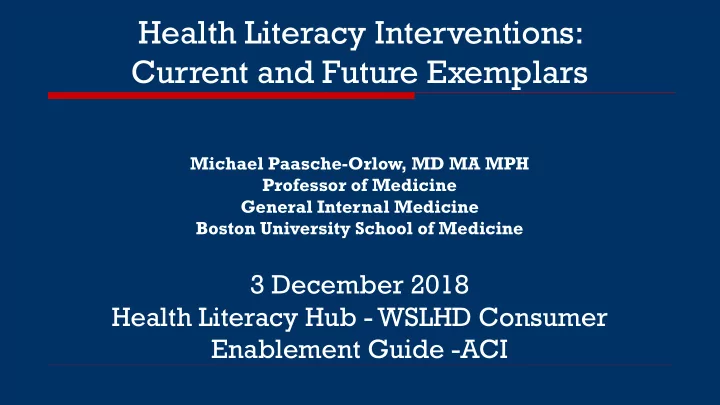

Health Literacy Interventions: Current and Future Exemplars Michael Paasche-Orlow, MD MA MPH Professor of Medicine General Internal Medicine Boston University School of Medicine 3 December 2018 Health Literacy Hub - WSLHD Consumer Enablement Guide -ACI
Peaels Raed Tihs Mnay plpoee hvae tbuorle wtih the slef-crae tksas tehy need ni oderr to saty hlaehty! Paesle rasie yuor hnad if you wnat to do snimoehtg aoubt it.
Water Funding Sunlight Marketing Protection Executive Sponsorship + Champions + Program Management
Federal Funders NCI AHRQ NIDDK NHLBI NIMH NIBIB NIMHD NHGRI NLM NIAAA CDC NIDA DOD NICHD HRSA NIDCR PCORI
https: / / health.gov/ communication/ hlactionplan/ pdf/ Health_Literacy_Action_Plan.pdf
National Action Plan Two core principles: • All people have the right to health information that helps them make informed decisions • Health services should be delivered in ways that are easy to understand and that improve health, longevity, and quality of life It will take everyone working together in a linked and coordinated manner to improve access to accurate and actionable health information and usable health services. By focusing on health literacy issues and working together, we can improve the accessibility, quality, and safety of health care; reduce costs; and improve the health and quality of life of millions of people.
Tremendous Attention on Rehospitalization Efficiency Allows for the alignment of improving quality and decreasing cost Plentiful 2006: 39.5 million hospital discharges with costs totaling $329.2 billion!
RED Checklist Eleven mutually reinforcing components: Adopted by Patient education Follow-up appointments National Quality Forum Outstanding tests as one of 30 Post-discharge services "Safe Practices" (SP-15) Medication reconciliation Reconcile dc plan with National Guidelines What to do if problem arises Dc summary to PCP Assess patient understanding Written discharge plan > Telephone Reinforcement
Operationalizing RED After Hospital Care Plan Discharge Educator Follow-up phone call
COVER PAGE
MEDICATION PAGE (1 of 3)
MEDICATION PAGE (2 of 3)
MEDICATION PAGE (3 of 3)
APPOINTMENT PAGE
APPOINTMENT CALENDAR
PATIENT ACTIVATION PAGE
Components of RED Intervention In Hospital – Nurse Discharge Educator Interacts with care team: medication reconciliation, appointments, and national guidelines Prepares and teaches After Hospital Care Plan Post Discharge – Clinical Pharmacist Calls for follow-up @ 72 hours post-dc Reinforces dc plan and review medications
Randomized Controlled Trial RED Intervention N=374 30-day Outcome Data Enrollment Randomization •Telephone Call N=749 •EMR Review Usual Care N=375 Enrollment Criteria: •English speaking •Have telephone •Able to independently consent •Not admitted from institutionalized setting •Adult medical patients admitted to Boston Medical Center (urban academic safety-net hospital) 48% Medicaid + 22% Free Care
Primary Outcome: Hospital Utilization within 30d after dc Usual Care Intervention P-value (n=370) (n=368) Hospital Utilizations * Total # of visits 166 116 Rate (visits/patient/month) 0.451 0.314 0.009 ED Visits Total # of visits 90 61 Rate (visits/patient/month) 0.245 0.165 0.014 Readmissions Total # of visits 76 55 Rate (visits/patient/month) 0.207 0.149 0.090 * Hospital utilization refers to ED + Readmissions
Cumulative Hazard Rate of Patients Experiencing Hospital Utilization 30 days After Index Discharge Cum ulative Hazard Rate 0 .3 0 .2 0 .1 Usual care Intervention p = 0.004 0 .0 0 5 1 0 1 5 2 0 2 5 3 0 Tim e after I ndex Discharge ( days)
Outcome Cost Analysis Usual Care Intervention Cost (dollars) Difference (n=370) (n=368) Hospital visits 412,544 268,942 - 143,602 ED visits 21,389 11,285 - 10,104 PCP visits 8,906 12,617 + 3,711 Total cost/group 442,839 292,844 - 149,995 Total cost/subject 1,203 791 - 412 We saved $412 in outcome costs for each patient given RED
ACP Decisions Video Library Categories
Education can Significantly Improve Decision-Making Video Decision Support Tools for ACP Quality Metrics Knowledge Decision certainty Stability of preferences Very well accepted by patients Helpful Comfortable Recommend
ACPDecisions.org
Embodied Conversational Agent • Emulate face-to-face communication using touch screen • Develop therapeutic alliance using Empathy Gaze Posture Gesture • Tailored information • Longitudinal conversation
ECA – Educator at the time of discharge from the hospital Who Would You Rather Receive Discharge Instructions From? N= 143 36% prefer agent 48% neutral 16% prefer doc or nurse “I prefer Louise, she’s better than a doctor, she explains more, and doctors are always in a hurry.” “It was just like a nurse, actually better, because sometimes a nurse just gives you the paper and says ‘Here you go.’ Louise explains everything.” 1=definitely prefer doc, 4=neutral, 7=definitely prefer agent
Intervention to Promote Walking in Older Adults Based on qualitative methods with members of our target audience, poor older adults, we designed “Tanya” to promote exercise behavior based on Social Cognitive Theory and the Transtheoretical Model of change
The ECA “Talks” and the user responds by touching Bickmore, Silliman, Nelson, Cheng, Winter, Henault, Paasche-Orlow. J Am Geriatr Soc. 2013 options on the screen
Advanced Illness Support Continual support over six months for Symptom Management Stress Management Physical Activity Promotion Advanced Care Planning Support Spiritual Counseling
Smartphone ECA Afib Kardia
IVR – Post Medication Rx EMC2 --> 50% -- > 50% !
Thank you! We have talked about a lot. What questions do you have? mpo@bu.edu
Recommend
More recommend